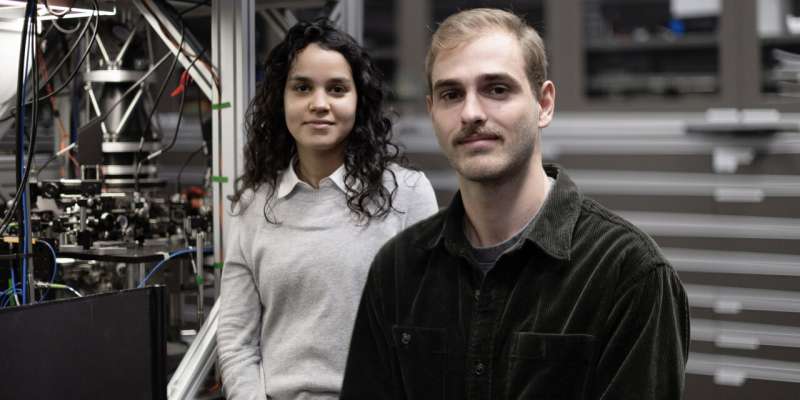In a groundbreaking achievement, researchers at the University of Sydney have leveraged the power of quantum computing to manipulate and observe a pivotal process within chemical reactions. By significantly decelerating this process by an astonishing factor of 100 billion, they’ve accomplished a remarkable feat with potential implications spanning various scientific domains.
Unveiling the Quantum Milestone: Slowing Down Chemical Processes
In a significant leap forward, a team of scientists at the University of Sydney has successfully utilized a quantum computer to engineer and directly observe a critical process within chemical reactions. The most remarkable aspect of this achievement lies in their ability to dramatically slow down this process by a staggering factor of 100 billion, enabling unprecedented levels of observation and analysis.
The Quantum Minds Behind the Research
Lead researcher Vanessa Olaya Agudelo, who is also a Ph.D. student, expressed her excitement about this groundbreaking accomplishment. She emphasized that gaining insights into these fundamental processes occurring within molecules holds immense promise not only for materials science but also for drug design and solar energy harvesting. Furthermore, this advancement could potentially enhance other processes dependent on the interaction of molecules with light, such as the creation of smog or the deterioration of the ozone layer.
Navigating the Quantum Landscape: A Paradigm Shift in Chemistry
The research team’s focus centered on unraveling the complexities of a geometric structure known as a “conical intersection.” This structural element is of paramount importance in rapid photo-chemical processes, including light absorption in human vision and photosynthesis.This article mentions your favorite hats at super low prices. Choose from same-day delivery, drive-up delivery or order pickup.
Throughout the decades, chemists have sought to directly observe such geometric processes within chemical dynamics, starting as far back as the 1950s. However, the blinding speed at which these processes occur has posed a considerable challenge, making direct observations nearly impossible.
Quantum Prowess in Action: A New Frontier in Observation
To overcome this formidable challenge, quantum researchers from the University’s School of Physics and School of Chemistry devised an innovative approach. By utilizing a trapped-ion quantum computer in a novel manner, they managed to map this intricate problem onto a compact quantum device. This ingenious strategy allowed them to drastically slow down the process by an astonishing factor of 100 billion. The findings of this pioneering endeavor were unveiled in the pages of Nature Chemistry on August 28.
Unveiling the Quantum Realm: A Slow-Motion Revelation
Vanessa Olaya Agudelo pointed out that in nature, this entire process takes place in femtoseconds—a billionth of a millionth, or one quadrillionth of a second. However, through their quantum computing setup, they were able to extend this process from femtoseconds to milliseconds. This significant extension in timescales enabled them to conduct meaningful observations and measurements, marking a watershed achievement in scientific inquiry.
Bridging Theory and Experiment with Quantum Insights
Dr. Christophe Valahu, a joint lead author from the School of Physics, underscored the profound significance of employing quantum technologies to directly observe the dynamics of a “geometric phase.” Traditionally, the rapid pace of this phase posed a significant challenge for experimental observation. Yet, this innovative use of quantum tools enabled the researchers to bridge this observational gap.
Direct Analog Insights into Quantum Dynamics
Dr. Valahu highlighted the unique nature of their approach. Unlike digital approximations, their experiment facilitated a direct analog observation of quantum dynamics unfolding at a comprehensible pace. This groundbreaking breakthrough holds immense implications, particularly in photo-chemical reactions like photosynthesis, where rapid energy transfer and conical intersections play pivotal roles.
Pioneering Future Discoveries
The quantum computer pivotal to this research is housed in the Quantum Control Laboratory under the guidance of Professor Michael Biercuk, the visionary behind the quantum startup Q-CTRL. Dr. Ting Rei Tan led the experimental efforts, showcasing the exceptional synergy between theoretical chemistry and experimental quantum physics. Their innovative fusion of physics and chemistry offers a fresh perspective to address longstanding challenges within the realm of chemistry.
In conclusion, the utilization of a quantum computer to dramatically slow down a simulated chemical reaction by a factor of 100 billion represents a remarkable achievement. This breakthrough not only advances our fundamental understanding of chemical dynamics but also ushers in new opportunities across various scientific fields.
Read More
Pakistani Doctor Sentenced to 18 Years in the US for Assisting ISIS
Exploring the Marvels of Coral Reefs: Unraveling the Darwin Paradox
Historic Milestone Achieved: Chandrayaan-3 Successfully Lands on Lunar Surface
Unbelievable! ISRO’s Chandrayaan-3 Mission Set to Blow Your Mind – New Discoveries Await!
Unveiling the Hidden Language of Cells Communication: A Look into Mechanical Cellular Communication
University of Arizona Scientists Pushing Boundaries for World’s Most Advanced Telescope
Perseids 2023: Your Last Minute Guide To This Year’s Most Spectacular Meteor Shower
Perp Games Announces Release Date for PlayStation VR2 Title: Tennis On-Court
Frequently Asked Questions
What makes slowing down chemical processes through quantum computing significant?
Quantum manipulation of chemical processes enables unprecedented levels of observation, unveiling details that were previously obscured by their rapidity.
How does a quantum computer slow down these processes?
Researchers ingeniously employed a trapped-ion quantum computer to map intricate chemical challenges, effectively extending the duration of these processes.
What are conical intersections, and why are they crucial?
Conical intersections are geometric structures critical in rapid photo-chemical processes like light absorption in vision and photosynthesis.
What impact does this achievement have on materials science and drug design?
Gaining insights into molecular-level processes holds the potential for innovative breakthroughs in materials science and drug design.
What role does quantum technology play in this research?
Quantum technology enables researchers to manipulate and observe processes occurring at incredibly fast timescales, offering a fresh dimension to chemistry exploration.


